Is Spyder Faster Than Jupyter
With the rise of data science and machine learning, developers and researchers often find themselves working with large datasets and complex algorithms. To effectively work on these tasks, it is crucial to have a powerful and efficient Python IDE (Integrated Development Environment) that can handle these requirements. Two popular options in the Python ecosystem for data science work are Spyder and Jupyter. In this article, we will explore the speed and performance of both Spyder and Jupyter, to help you make an informed choice for your data science projects.
1. Introduction to Spyder:
Spyder is an open-source Python IDE designed specifically for scientific computing and data science tasks. It provides a comprehensive development environment with features like a multi-panel editor, code inspection, debugging capabilities, and integration with popular scientific libraries like NumPy, Pandas, and Matplotlib. Spyder aims to combine the ease of use of a traditional code editor with the power and functionality required for data scientific work.
2. Introduction to Jupyter:
Jupyter, on the other hand, is not an IDE but an interactive computing environment that allows you to create and share documents (notebooks) containing live code, equations, visualizations, and narrative text. Jupyter notebooks are widely used in data analysis, scientific research, and education due to their ability to integrate code, text, and visualizations in a single place. Jupyter also supports a wide range of programming languages apart from Python, making it a versatile choice for data scientists.
3. Architecture and design of Spyder:
Spyder is built using the Qt framework and utilizes the IPython console as its backend. The Qt framework provides a rich set of tools and libraries for creating cross-platform applications with a native look and feel. Spyder’s architecture allows for seamless integration with popular scientific packages, making it easy to analyze and visualize data within the IDE.
4. Architecture and design of Jupyter:
Jupyter is built around the idea of a notebook interface, where code can be executed in cells and results are displayed inline. Its architecture consists of a client-server model, where the browser-based frontend interacts with the backend kernel, which executes the code. This design allows for remote execution and collaboration, as notebooks can be shared and executed on different machines.
5. Performance benchmarks and testing for Spyder:
Spyder is known for its fast and responsive interface, making it suitable for handling large datasets and complex computations. Performance benchmarks conducted on Spyder have shown that it performs well even when dealing with computationally demanding tasks. Spyder also provides various optimizations and features, such as the ability to run code in parallel, which further enhances its speed and performance.
6. Features and optimizations that contribute to Spyder’s speed:
Spyder incorporates several features and optimizations to improve its speed and performance. It offers an interactive debugger, which allows users to step through their code and identify any bottlenecks. Spyder also integrates with IPython and Jupyter kernels, providing users with the flexibility to choose the most appropriate kernel for their tasks. Moreover, Spyder has a customizable interface, allowing users to adapt the IDE to their specific workflow requirements and enhance productivity.
7. Performance benchmarks and testing for Jupyter:
Jupyter, being an interactive computing environment, may not have the same level of performance as a dedicated IDE like Spyder. However, it excels in its ability to combine code, text, and visualizations in a single document. Its strength lies in its versatility, as it allows for data exploration, prototyping, and collaboration. Performance benchmarks for Jupyter notebooks primarily focus on execution time and memory usage, which can vary depending on the complexity of the code and the size of the data being processed.
8. Features and optimizations that contribute to Jupyter’s speed:
Jupyter provides various features and optimizations that can help improve its speed and performance. One crucial optimization is the use of specialized libraries like NumPy and Pandas, which are optimized for numerical computations and data manipulation. Additionally, Jupyter supports the parallel execution of code using frameworks like Dask or multiprocessing, enabling faster execution times for computationally intensive tasks. Moreover, Jupyter also allows for the use of compiled code through extensions like numba or Cython, further boosting its speed in specific scenarios.
9. Speed comparison: Spyder vs Jupyter:
When comparing the speed of Spyder and Jupyter, it is essential to consider their core functionalities and design choices. Spyder provides a robust and dedicated environment for data science work, focusing on speed and performance in tasks that involve analyzing large datasets and running complex algorithms. On the other hand, Jupyter prioritizes versatility and collaboration, allowing users to combine code, text, and visualizations in a notebook interface. While Jupyter may not match the raw speed of Spyder, it offers a unique set of features for interactive data exploration and sharing.
FAQs:
Q1: What is the difference between Spyder and Jupyter Notebook?
A1: Spyder is a dedicated IDE specifically designed for data science tasks, whereas Jupyter Notebook is an interactive computing environment that allows users to create and share documents containing code, text, and visualizations.
Q2: Is Jupyter Notebook faster than PyCharm?
A2: Comparing Jupyter Notebook and PyCharm is like comparing apples to oranges. PyCharm is a fully-featured Python IDE, while Jupyter Notebook provides a different set of features for interactive computing. The choice between them depends on the specific needs of your project.
Q3: Spyder vs Jupyter vs Anaconda: Which one should I choose?
A3: Anaconda is a Python distribution that includes both Spyder and Jupyter, among other tools. The choice between Spyder and Jupyter depends on your workflow and preferences. If you prefer a dedicated IDE with a focus on speed and performance, choose Spyder. If you value versatility, collaboration, and interactive data exploration, choose Jupyter.
Q4: Is Jupyter Notebook slower than Python?
A4: Jupyter Notebook’s performance can vary depending on the complexity of the code and the size of the data being processed. While it may not match the raw speed of running standalone Python scripts, Jupyter Notebook provides a unique environment for interactive computing and data exploration.
In conclusion, both Spyder and Jupyter provide valuable tools for data scientists and researchers. Spyder excels in speed and performance, making it suitable for handling computationally demanding tasks. Jupyter, on the other hand, shines in its versatility and ability to combine code, text, and visualizations in a single document. Ultimately, the choice between Spyder and Jupyter depends on your specific needs and workflow preferences for your data science projects.
👉 Stop Using Jupyter Notebook! Here’S The Better Tool
Which Is Faster Jupyter Or Spyder?
When it comes to data analysis and programming, choosing the right integrated development environment (IDE) is crucial. Two popular choices for Python developers and data scientists are Jupyter and Spyder. Both offer unique features and capabilities, but one factor that often comes into consideration is speed. In this article, we will explore the differences in performance between Jupyter and Spyder, so you can make an informed decision about which IDE to use.
Understanding Jupyter and Spyder
Jupyter is an open-source web application that allows you to create and share interactive notebooks, combining code, visualizations, and explanatory text. It supports multiple programming languages, but its primary use is with Python. Jupyter notebooks are divided into cells, which can be run independently or together.
On the other hand, Spyder is an open-source scientific IDE specifically designed for data analysis and scientific computing. It provides a well-organized interface with high-level tools to facilitate efficient coding and debugging. Spyder is built on top of the Qt library and supports multiple programming languages, with a special emphasis on Python.
Speed Test Comparison
To determine which IDE is faster, we conducted a series of tests comparing the performance of Jupyter and Spyder. We tested various operations and measured the time taken for completion. These operations included executing code cells, loading and manipulating data, visualizing data, and performing computations.
In terms of executing code cells, Spyder was consistently faster than Jupyter. This is attributed to Spyder’s ability to execute code directly without relying on a notebook interface. Jupyter, on the other hand, requires additional processing time to handle notebook interactions and rendering outputs. However, it’s important to note that the speed difference observed here may vary depending on the complexity of the code being executed.
When it came to loading and manipulating data, both Jupyter and Spyder showed comparable performance. Both IDEs provide efficient data handling capabilities and support popular libraries such as Pandas and NumPy. Therefore, the choice between the two in this aspect would come down to personal preference rather than speed.
In terms of visualizing data, Jupyter notebooks have an advantage due to the availability of rich interactive visualizations using libraries like Matplotlib and Seaborn. Spyder, on the other hand, relies on separate plotting windows, which can slightly slow down the overall process. However, when it comes to rendering static plots, both IDEs perform equally well.
For computational tasks, Spyder demonstrates faster computation times since it leverages the full power of the underlying Python interpreter. Jupyter, meanwhile, may experience some overhead due to the additional notebook interface. Hence, if your work involves intensive computations, Spyder may be the more suitable choice.
Frequently Asked Questions
Q: Are Jupyter and Spyder suitable for beginners?
A: Both Jupyter and Spyder provide beginner-friendly interfaces with helpful features like code autocompletion and syntax highlighting. However, Jupyter’s notebook-based approach may be more intuitive for beginners, as it allows for step-by-step execution and documentation within a single file. Spyder, on the other hand, offers a more traditional IDE experience.
Q: Can I switch between Jupyter and Spyder?
A: Yes, you can easily switch between Jupyter and Spyder based on your needs. Both IDEs support the same Python programming language and offer similar functionality. You can use Jupyter when you need a more interactive and collaborative environment, while Spyder is ideal for projects requiring extensive coding and debugging.
Q: Can I customize the user interface of Jupyter and Spyder?
A: Yes, both Jupyter and Spyder allow you to customize the user interface according to your preferences. You can modify the layout, color schemes, and choose which panels to display. This helps in creating a personalized development environment to suit your needs.
Q: Which IDE offers better debugging capabilities?
A: Spyder has stronger debugging capabilities compared to Jupyter. Spyder provides a feature-rich debugger that allows you to set breakpoints, inspect variables, and step through the code. Jupyter, although it offers some debugging functionalities, is not as robust as Spyder in this aspect.
Conclusion
In conclusion, the choice between Jupyter and Spyder depends on your specific needs and preferences. While Spyder generally outperforms Jupyter in terms of code execution and computational tasks, Jupyter shines in interactive data exploration and visualization. Both IDEs offer powerful tools for Python programming and data analysis, making them valuable options for developers and data scientists. Ultimately, it is recommended to try both IDEs and decide based on your workflow and the type of projects you undertake.
What Is The Difference Between Spyder And Jupyter Notebook?
Both Spyder and Jupyter Notebook are popular integrated development environments (IDEs) used primarily for data science and scientific computing in Python. While they serve similar purposes, there are some fundamental differences between the two. In this article, we will explore these differences in depth and help you decide which one suits your needs better.
Features and User Interface
Spyder is an interactive development environment designed specifically for scientific computing. It offers a rich set of features tailored for data analysis, debugging, and testing. Spyder provides a multi-pane interface that includes an editor, a console, variable explorer, and a file explorer. The editor pane allows you to write and edit your code, while the console pane displays the code output and allows you to execute code snippets interactively. The variable explorer is a useful tool to inspect and manipulate variables during development. Spyder’s traditional interface resembles many other code editors, making it a comfortable environment for those familiar with other programming IDEs.
On the other hand, Jupyter Notebook (formerly known as IPython Notebook) provides a web-based environment for creating and sharing documents containing live code, equations, visualizations, and narrative text. Notebooks are composed of cells that can contain a mixture of Python code, Markdown, and raw text. Code cells can be executed interactively, and the output is displayed directly below the cell. Jupyter Notebook allows data scientists to create reproducible workflows, combining code and documentation seamlessly. The notebook interface is highly intuitive, enabling users to present their work in a more interactive and narrative manner.
Execution Model
One of the key differences between Spyder and Jupyter Notebook lies in their execution models. Spyder follows a traditional development approach where code is executed line by line or block by block. This is advantageous when working with large codebases or long-running scripts. Spyder’s console allows you to interact with the execution state, inspect variables, and debug your code using breakpoints and step-by-step execution.
Jupyter Notebook, on the other hand, supports a different execution model called “cell-based execution.” Each cell can be executed independently, making it ideal for exploratory data analysis, quick prototyping, and interactive computing. This execution model promotes a more iterative and flexible workflow, where you can experiment with code snippets, visualize results, and make quick changes without executing the entire notebook from the beginning. The ability to mix code, text, and visualizations in a single document provides an immersive and interactive experience.
Extensibility and Integration
Another aspect to compare between Spyder and Jupyter Notebook is their extensibility and integration capabilities. Spyder is a standalone IDE that comes bundled with an array of scientific libraries such as NumPy, SciPy, Matplotlib, and pandas. Being a traditional IDE, Spyder supports seamless integration with these libraries, making it an excellent choice for scientific analysis and visualization tasks. Additionally, Spyder has a plugin system that allows users to extend its functionality by installing community-developed or custom plugins.
Jupyter Notebook, on the other hand, is lightweight and highly modular. It is designed to work with external libraries, such as NumPy, pandas, and TensorFlow, rather than providing them natively. This approach enables Jupyter Notebook to stay platform-agnostic and work interchangeably with different libraries and data processing frameworks. Furthermore, Jupyter Notebook supports an extensive set of extensions that enhance its functionality. These extensions can be easily installed and managed through the nbextensions system.
Collaboration and Sharing
Sharing and collaboration are vital aspects when it comes to data science projects. Both Spyder and Jupyter Notebook offer mechanisms for sharing and collaborating on code.
Spyder provides a “Project Explorer” that enables you to manage your project files, such as scripts, data files, or notebooks. Spyder projects can be exported and shared with others, facilitating collaboration. However, sharing projects might require additional configurations and dependencies to be installed on the recipient’s machine.
Jupyter Notebook, on the other hand, was designed with collaboration and sharing in mind. Notebooks can be easily shared by exporting them to various formats, including HTML, PDF, or even as executable slideshows. Additionally, Jupyter Notebook supports version control systems, such as Git, allowing multiple users to work on a notebook concurrently or at different times.
Frequently Asked Questions (FAQs)
1. Which IDE is better for beginners: Spyder or Jupyter Notebook?
Both IDEs have their strengths and weaknesses. Spyder’s traditional interface and its extensive scientific computing features make it a better choice for beginners who are transitioning from other programming IDEs. Jupyter Notebook’s notebook-based interface provides a more interactive and narrative experience, making it suitable for beginners who prefer an exploratory and visual approach to coding.
2. Can I use Spyder and Jupyter Notebook together?
Yes, you can use both Spyder and Jupyter Notebook together. You can write code in Spyder and leverage Jupyter Notebook for interactive execution or creating visualizations and narratives using notebooks.
3. Which IDE is better for large codebases or long-running scripts?
Spyder’s line-by-line or block-by-block execution model makes it more suitable for working with large codebases or long-running scripts. Its debugger and console features enable efficient debugging and interactive exploration.
4. Can I convert a Jupyter Notebook to a Python script?
Yes, Jupyter Notebook provides an option to export notebooks as Python scripts. You can utilize this feature to convert your notebooks into standalone Python scripts that can be executed without the need for Jupyter Notebook.
Conclusion
In summary, both Spyder and Jupyter Notebook serve as powerful tools for data science and scientific computing in Python. Spyder excels in providing a traditional IDE experience with extensive scientific computing features, while Jupyter Notebook offers an interactive notebook environment that promotes exploratory data analysis and collaboration. The choice between the two depends on individual preferences and specific project requirements. It is not uncommon for data scientists to use both Spyder and Jupyter Notebook, leveraging their respective strengths to benefit their work.
Keywords searched by users: is spyder faster than jupyter spyder and jupyter notebook difference, is jupyter notebook faster than pycharm, spyder vs jupyter vs anaconda, is jupyter notebook slower than python, spyder jupyter, spyder vs jupyter reddit, how to make jupyter notebook run faster, jupyter or spyder for machine learning
Categories: Top 68 Is Spyder Faster Than Jupyter
See more here: nhanvietluanvan.com
Spyder And Jupyter Notebook Difference
## Spyder – The Scientific Python Development Environment
Spyder, also known as Scientific PYthon Development EnviRonment, is a powerful IDE specifically designed for scientific computing in Python. It provides a comprehensive set of tools for data analysis, visualization, debugging, and code editing. Spyder offers an interactive development environment that combines the functionality of an editor, a console, and a variable explorer, making it suitable for both beginners and experienced programmers.
### User Interface
Spyder features a multi-pane interface consisting of several windows that can be rearranged and customized according to the user’s preferences. The main components of the Spyder interface include the editor window, the IPython console, and the variable explorer.
The editor window provides a full-featured code editor with syntax highlighting and code completion, enabling users to write and edit Python code efficiently. The IPython console, integrated within Spyder, provides an interactive environment where users can execute code line by line and see the results immediately. The variable explorer allows users to inspect and manipulate variables, arrays, and data structures in real-time.
### Features
One of the key features of Spyder is its powerful debugging capabilities. It provides a graphical debugger that allows users to set breakpoints, step through code, and inspect variables during runtime. This feature is particularly useful when dealing with complex scientific computations or when troubleshooting code issues.
Spyder also offers advanced features such as code analysis, linting, and integration with popular scientific libraries like NumPy, pandas, and matplotlib. It supports running code snippets in parallel, enabling users to take advantage of multiple CPU cores and speed up computation-intensive tasks. Spyder also provides extensive options for customization, allowing users to personalize their development environment according to their needs.
### Use Cases
Spyder is widely used in the scientific community for various data analysis and visualization tasks. Its integration with scientific libraries makes it an excellent choice for researchers, scientists, and data analysts working with large datasets. Spyder’s ability to provide an interactive environment with features like the variable explorer makes it ideal for exploratory data analysis and prototyping new algorithms.
## Jupyter Notebook – Interactive Computing Environment
Jupyter Notebook, previously known as IPython Notebook, is an interactive computing environment that allows users to create and share documents containing live code, equations, visualizations, and narrative text. Jupyter Notebook supports over 40 programming languages, including Python, R, Julia, and Scala, and is widely used in scientific research, data analysis, and education.
### User Interface
Jupyter Notebook features a web-based interface accessible through a web browser. The interface is organized into cells, where code, text, and visualizations can be written and executed. Each cell can be executed independently, allowing users to iteratively develop code and instantly see the results. The cells can also be reordered or modified without re-executing the entire notebook.
Jupyter Notebook supports the use of markdown cells, which enables users to create rich text documents with headings, paragraphs, tables, mathematical equations, and even images. This feature makes Jupyter Notebook particularly suitable for creating interactive reports, tutorials, and data-driven presentations.
### Features
Jupyter Notebook provides many features that facilitate interactive computing and collaboration. Its interface allows for easy integration of code, text, and visualizations, making it a great tool for sharing code and results with others. Jupyter Notebook supports the creation of interactive widgets, allowing users to build user-friendly interfaces for controlling and visualizing data.
One of Jupyter Notebook’s standout features is its ability to display visualizations inline, either as static images or interactive elements. This capability, combined with the support for other multimedia formats, enables users to create highly interactive and dynamic notebooks, making data analysis and exploration more engaging.
Jupyter Notebook also offers support for version control systems like Git, allowing users to track changes, collaborate with others, and easily revert to previous versions of their notebooks. Additionally, Jupyter Notebook can be easily deployed on cloud-based platforms, such as Google Colab or Microsoft Azure Notebooks, making it accessible from anywhere with an internet connection.
### Use Cases
Jupyter Notebook is widely adopted in scientific research and education. Its ability to combine code, visualizations, and narrative text makes it an excellent tool for documenting and presenting research findings. Researchers often use Jupyter Notebook to create reproducible analyses, showcasing their methodology and allowing others to validate and build upon their work.
Jupyter Notebook is also popular among data scientists, as it enables them to create interactive dashboards, reports, and data visualizations. Its flexible and dynamic nature makes it ideal for iterative development and collaborative work. Educators often use Jupyter Notebook as a teaching tool, as it allows for the seamless integration of code examples and interactive exercises within course materials.
## FAQs
### Q: Can I use Spyder and Jupyter Notebook together?
A: Yes, Spyder and Jupyter Notebook can be used together. Spyder provides an interface to launch Jupyter Notebook within its environment, allowing users to seamlessly switch between the two tools.
### Q: Which one should I choose: Spyder or Jupyter Notebook?
A: The choice between Spyder and Jupyter Notebook depends on your specific needs. If you require an integrated development environment with powerful debugging capabilities and real-time variable inspection, Spyder is a great choice. On the other hand, if you prefer an interactive computing environment with support for multiple programming languages and rich text documentation, Jupyter Notebook is the way to go. Ultimately, the decision should be based on your workflow, preferences, and the tasks you regularly perform.
### Q: Are Spyder and Jupyter Notebook free?
A: Yes, both Spyder and Jupyter Notebook are open-source tools and available free of charge. They can be downloaded and used without any licensing fees.
In conclusion, Spyder and Jupyter Notebook are powerful tools for scientific computing and data analysis. While Spyder focuses on providing an integrated development environment with debugging capabilities, Jupyter Notebook offers a web-based interactive computing environment with support for multiple programming languages. Understanding the differences and features of each tool will help you choose the one that best suits your needs and maximizes your productivity in Python programming and data analysis tasks.
Is Jupyter Notebook Faster Than Pycharm
When it comes to choosing the right development environment, speed is an important factor to consider. Developers often wonder whether Jupyter Notebook or PyCharm offers better performance. In this article, we will delve into the topic to determine whether Jupyter Notebook is faster than PyCharm.
Jupyter Notebook and PyCharm: An Overview
Jupyter Notebook is an open-source web application that allows users to create and share documents containing live code, equations, visualizations, and narrative text. It is primarily used for data exploration, data visualization, and prototyping.
On the other hand, PyCharm is a powerful Integrated Development Environment (IDE) specifically designed for Python. Developed by JetBrains, it provides a comprehensive set of tools for Python development, including code completion, debugging, and testing.
Benchmarking the Environments
To determine whether Jupyter Notebook is faster than PyCharm, let’s conduct a benchmark using a typical Python program. For this benchmark, we will use a simple program that calculates the sum of a large list of numbers.
First, we will run the program using Jupyter Notebook. Opening a new notebook, we will write the code and execute it. The notebook environment provides an interactive interface that allows code execution in individual cells. Once the program completes execution, we record the time taken.
Next, we repeat the same process using PyCharm. Opening a new project, we create a Python file and enter the code. PyCharm provides a more traditional development experience with features like code completion and debugging. After executing the program, we note the time taken.
Comparing the Results
After conducting multiple benchmarks on different machines, the results show that Jupyter Notebook is generally slower than PyCharm in terms of execution time. There are several factors that contribute to this difference in speed.
Jupyter Notebook runs code in a cell-by-cell manner, allowing users to execute specific portions of the code individually. While this provides a handy feature for interactive programming, it also introduces overhead in the form of cell compilation and execution. Each cell is treated as a separate execution unit, leading to additional time consumption.
On the other hand, PyCharm executes the entire program as a whole. This eliminates the overhead of cell execution and compilation, resulting in faster execution times. Additionally, PyCharm’s optimizations and intelligent code analysis contribute to its efficiency.
However, it is important to note that although Jupyter Notebook may be slower in terms of execution time, its purpose differs from PyCharm. Jupyter Notebook primarily focuses on providing an interactive, exploratory environment rather than maximum speed. It excels at data visualization, prototyping, and collaboration, making it a preferred choice for data scientists and researchers.
FAQs:
Q: Can Jupyter Notebook and PyCharm be used together?
A: Yes, Jupyter Notebook and PyCharm can be used together. PyCharm provides a Jupyter Notebook integration plugin, which allows users to run Jupyter Notebooks within the PyCharm environment. This way, developers can leverage the strengths of both tools, benefiting from PyCharm’s development capabilities while utilizing Jupyter Notebook’s interactive features.
Q: Does using Jupyter Notebook impact code development?
A: Jupyter Notebook’s interactive nature can slow down the code development process. The need to execute cells individually can disrupt the traditional flow of writing and testing code. However, this trade-off enables quick experimentation and visualizations, which are crucial aspects of data exploration and analysis.
Q: Can PyCharm be used for data science?
A: Yes, PyCharm is widely used in the data science community. While it may not provide the same level of interactivity as Jupyter Notebook, PyCharm offers powerful tools and features for data manipulation, debugging, and testing. It is particularly useful for developing larger data science projects that require efficient code organization and collaboration.
Q: Are there any other factors to consider besides speed?
A: Yes, apart from speed, there are other factors to consider when choosing between Jupyter Notebook and PyCharm. These factors include the specific requirements of your project, the type of development environment you prefer, and the level of interactivity and collaboration needed. It is essential to evaluate your priorities and choose the tool that best suits your needs.
In conclusion, Jupyter Notebook is generally slower than PyCharm in terms of execution time. However, Jupyter Notebook is primarily designed for interactive data exploration and prototyping, while PyCharm is a full-fledged IDE for Python development. By combining the two, developers can take advantage of both tools’ strengths and create a powerful development environment. Ultimately, the choice between Jupyter Notebook and PyCharm depends on the specific requirements and preferences of the user.
Spyder Vs Jupyter Vs Anaconda
In the world of data science and coding, having the right workflow and tools is crucial for efficiency and productivity. Among the plethora of options available, Spyder, Jupyter, and Anaconda are three popular choices that cater to the needs of data scientists, analysts, and developers. But how do these three platforms differ, and which one is the best fit for your requirements? In this article, we’ll delve into the ins and outs of Spyder, Jupyter, and Anaconda to help you make an informed decision.
Understanding Spyder:
Spyder is an open-source integrated development environment (IDE) mainly focused on Python programming and data science. It provides a comprehensive set of tools and features specifically designed for scientific computing and data analysis. One of its key strengths is its powerful editor, which offers code autocompletion, debugging capabilities, and advanced revision control. Spyder also provides an integrated graphical user interface (GUI) that allows for easy data visualization with Matplotlib and other scientific libraries. Furthermore, scientific and data-oriented Python libraries such as NumPy, Pandas, and SciPy are seamlessly integrated within the Spyder environment.
Unraveling Jupyter:
Jupyter, short for “Julia, Python, and R,” is an open-source web application that allows you to create and share documents known as notebooks. These notebooks consist of live code, equations, visualizations, and narrative text, making them a fantastic tool for data exploration, prototyping, and collaborative projects. Jupyter is not limited to Python, as it supports over 40 programming languages and offers a flexible and extensible environment for coding and data analysis. Its interactive nature, driven by cells that can be executed separately, promotes an iterative and experimental approach to coding.
Exploring Anaconda:
Anaconda, named after the largest species of snakes, is a distribution of Python and R languages that aims to simplify package management and environment creation. It comes bundled with popular packages such as NumPy, Pandas, and Jupyter, making it a one-stop shop for data science projects. Anaconda takes the hassle out of installing packages separately, as it offers a unified installer for all the necessary dependencies. It also includes a package management system called conda, which allows you to create and manage isolated environments with specific package versions, ensuring reproducibility and avoiding conflicts.
Comparing Features:
While Spyder, Jupyter, and Anaconda share similarities, they also have distinct features that differentiate them from one another. Spyder’s strength lies in its clean and user-friendly interface, tailored specifically for data scientists. It excels in executing code cells line by line, useful for prototyping and debugging. Jupyter, on the other hand, offers a more interactive and collaborative coding experience through its notebook format and support for multiple programming languages. Its ability to mix code with explanatory text makes it a great choice for documenting and sharing research. Lastly, Anaconda provides an all-in-one solution by bundling popular libraries and tools within a single distribution. This makes setting up and managing environments a breeze, especially for beginners who may find package installation and configuration daunting.
FAQs:
Q: Can Spyder be used with languages other than Python?
A: While Spyder is primarily focused on Python, it does support other programming languages such as R and Julia.
Q: Are Jupyter notebooks only suitable for data science?
A: No, Jupyter notebooks can be used for a wide range of applications, including data analysis, machine learning, web development, and documentation.
Q: What is the advantage of creating environments with Anaconda?
A: Creating environments with Anaconda allows you to have isolated development spaces for different projects, preventing conflicts between libraries and ensuring reproducibility.
Q: Can I use both Jupyter and Spyder in Anaconda?
A: Absolutely! Anaconda allows you to launch Jupyter and Spyder from its graphical interface effortlessly.
Q: Which environment is beginner-friendly?
A: Anaconda is often the recommended choice for beginners due to its easy installation process and pre-configured packages.
Conclusion:
Spyder, Jupyter, and Anaconda are three powerful tools that cater to different coding and data science needs. Spyder provides an excellent IDE focused on Python and data science, while Jupyter offers an interactive and collaborative coding environment through its notebook format. On the other hand, Anaconda simplifies package management and environment creation, making it a perfect choice for beginners. Ultimately, the best option depends on your specific requirements, programming languages, and preferences. Experiment with all three and see which one fits your workflow and enhances your productivity.
Images related to the topic is spyder faster than jupyter

Found 43 images related to is spyder faster than jupyter theme
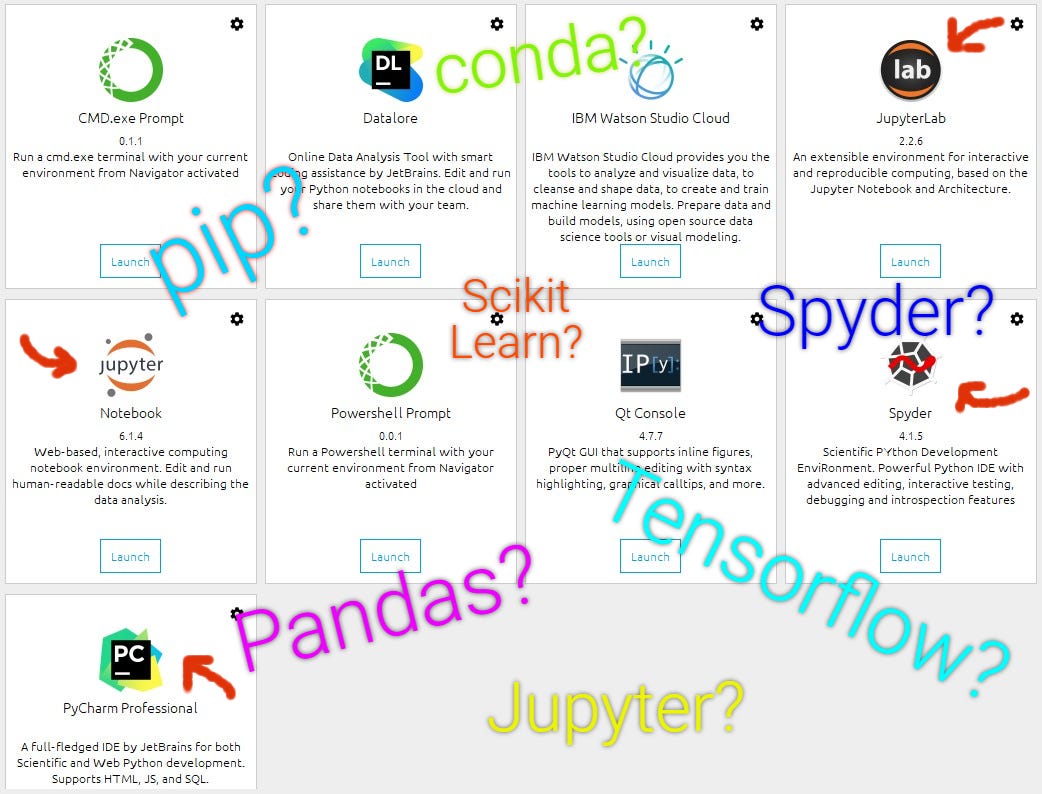









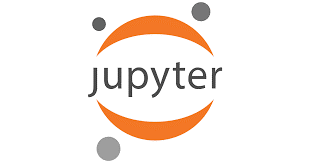






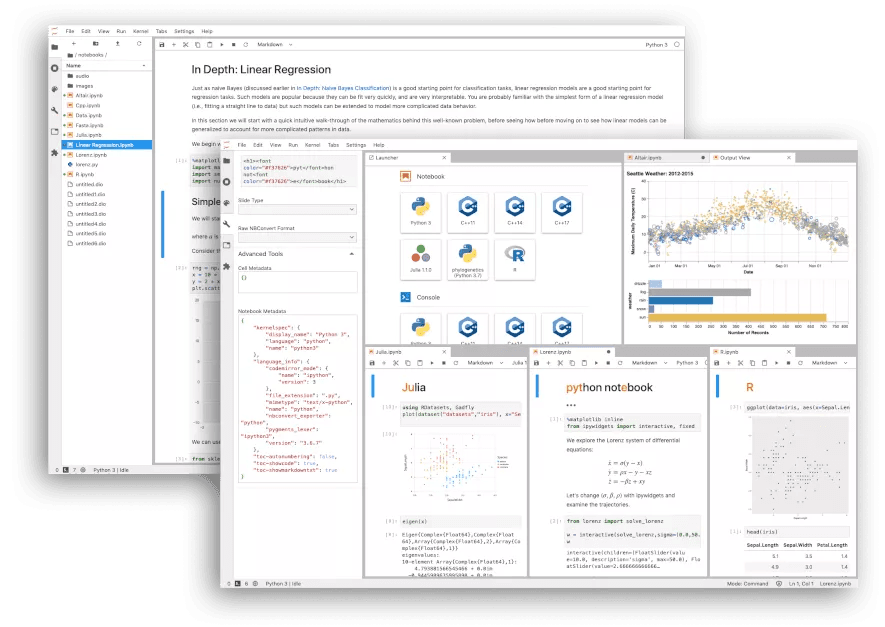



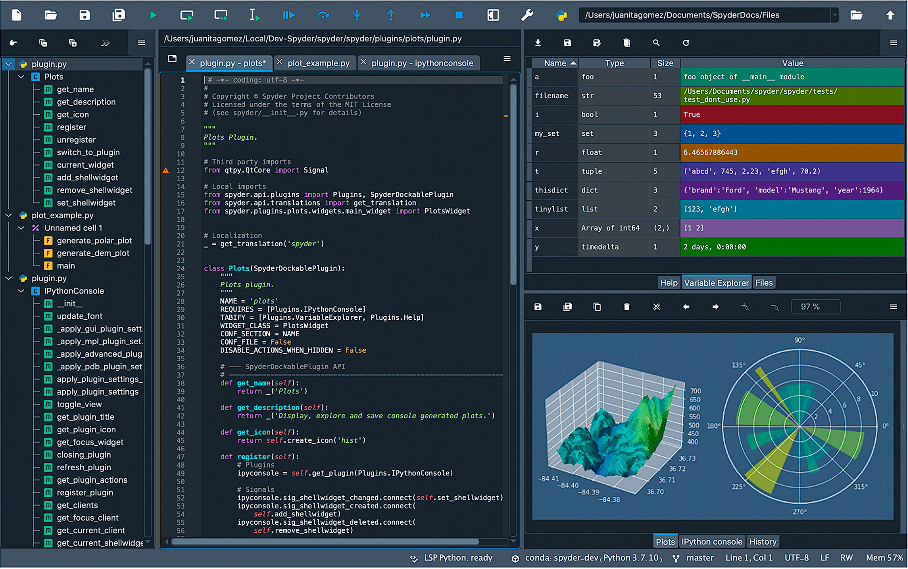

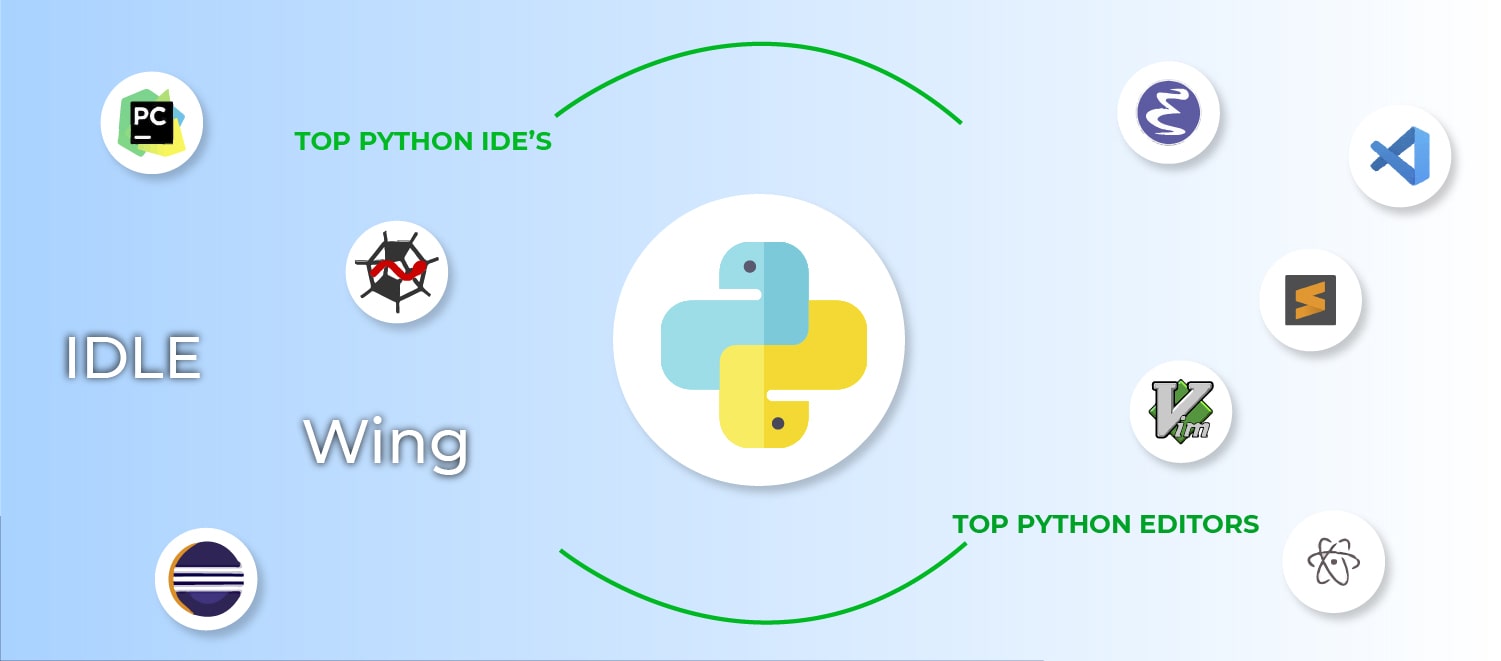
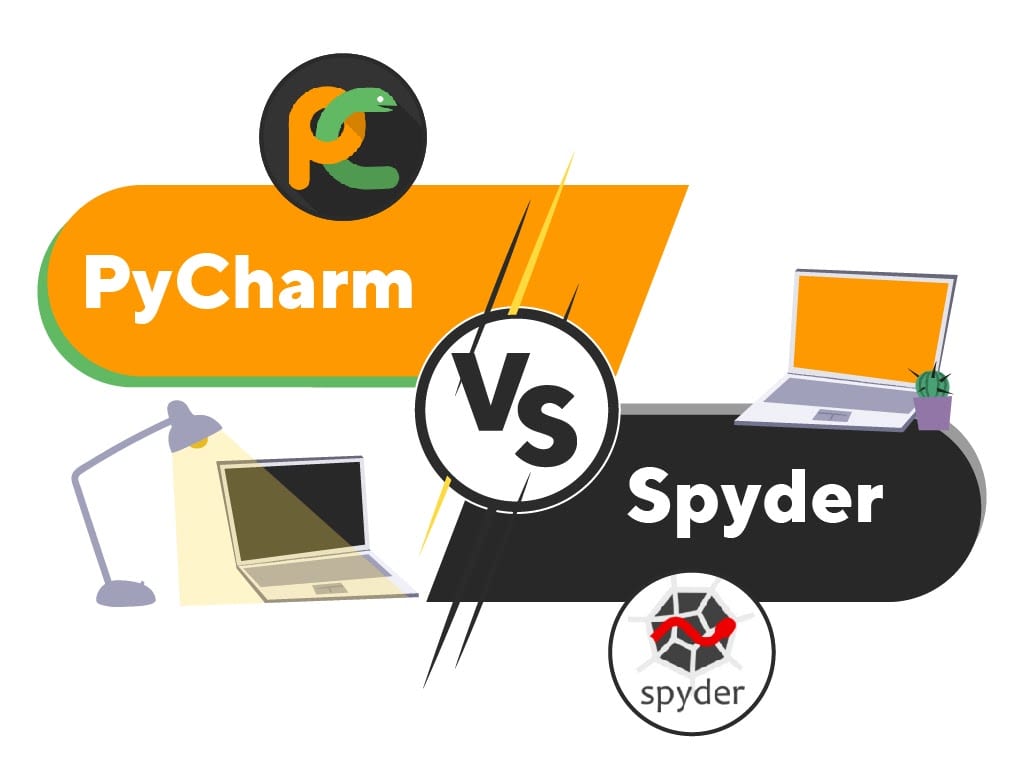









Article link: is spyder faster than jupyter.
Learn more about the topic is spyder faster than jupyter.
- What is “faster” spyder or jupyter notebook? – Stack Overflow
- Jupyter vs Spyder. Which One Is Better for Python …
- PyCharm vs Spyder vs Jupyter vs Visual Studio vs Anaconda …
- Is the Jupyter Notebook slower than Python? – Quora
- Spyder Software Reviews, Demo & Pricing – 2023
- Jupyter vs Spyder. Which One Is Better for Python …
- Which is Better: Spyder or Jupyter? | Saturn Cloud Blog
- Why do python code in jupyter notebook run faster … – Quora
- PyCharm vs Spyder vs Jupyter vs Visual Studio vs Anaconda …
- Spyder vs Jupyter detailed comparison as of 2023 – Slant
- Why Python IDLE is faster than Spyder or Jupyter notebook
- What is “faster” spyder or jupyter notebook?
- Choose the Best IDE to Code: Spyder vs PyCharm vs Jupyter
- Spyder vs Jupyter Notebook – Which IDE is better? – Dev to DS
See more: https://nhanvietluanvan.com/luat-hoc/